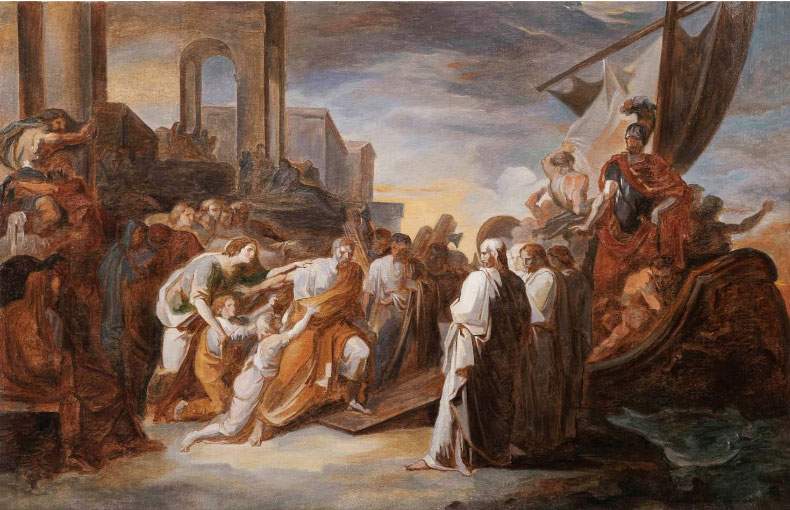An international exhibition between Rome and Paris to celebrate two protagonists of late 18th- and early 19th-century art, namely Vincenzo Camuccini (Rome, 1771 - 1844), a great artist of Roman Neoclassicism, and his son Giovanni Battista Camuccini (Rome, 1819 - 1904), who was instead a sensitive interpreter of the Romantic landscape en plein air. The exhibition, entitled I Camuccini. Between Neoclassicism and Romantic Sentiment, is a project of two galleries, Antonacci Lapiccirella Fine Art in Rome and Maurizio Nobile Fine Art in Paris (also with venues in Bologna and Milan), representing the opening of their exhibition season. The dates are October 1 to 28, 2021 at the Antonacci Lapiccirella Fine Art gallery, November 5 to 11 at Galerie Eric Coatalem in Paris (during the days of the Paris Fine Art fair taking place), and November 16 to December 3 at the Paris branch of Maurizio Nobile Fine Art.
The exhibition aims to unite not only the galleries but also the two European capitals that host them, where the neoclassical ideal was born and found fertile ground between the mid-eighteenth century and the early decades of the nineteenth century. The exhibition includes a selection of more than fifty works through which the artistic vicissitudes of the two Camuccini will be narrated, beginning with Vincenzo’s long and glorious career, which led him to become one of the leading exponents of European neoclassicism, as well as a witness to one of the most intense periods in the history of Rome. Indeed, his work turns out to be profoundly influenced by the political context of the capital, in which he was actively engaged. The pictorial style changes when Vincenzo assumes a very clear role, that of interpreter and witness of the Empire and the Restoration, when he realizes and the belief that the Athens of Pericles and the Rome of virtuous times can survive in the Republic is lost.
In addition, the exhibition will attempt to give an assessment of Camuccini through the works on display, which include an extraordinary series of unpublished drawings dating back to the formative period that saw the young Vincenzo first practicing on the works of the great masters of the past and later perfecting himself on the level of invention by attending theAccademia de’ Pensieri, started in the capital by Felice Giani in the early 1990s. In the exhibition itinerary, the paintings of Roman history, with which Camuccini achieved international fame, so much so that he soon became its most up-to-date interpreter compared to the more common late 18th-century interpretation put forth until then in the capital, assume great prominence. Prominent among these works areAppius Claudius, a sketch for the monumental Death of Virginia (Naples, Museo di Capodimonte) commissioned by Frederick August Hervey bishop of Derry and 4th Earl of Bristol, and the Departure of Attilius Regulus executed for the Duke of Blacas. Completing the exhibition itinerary are a series of religious studies related to ecclesiastical commissions, such as the St. Simon for the altar of St. Peter’s in the Vatican basilica.
The exhibition is also entrusted with recounting the landscape vocation of Giovanni Battista Camuccini (whose art-historical relevance transcends national borders, to the point that many of his works are preserved in the most important foreign museums, including the National Gallery in London, the Metropolitan in New York and the Toledo Art Museum) through a series of enchanting views of the Latium countryside. A vocation developed in the wake of the specialist Giambattista Bassi (Massa Lombarda, 1784 - Rome, 1852), who in Rome renewed the tradition of classical seventeenth-century landscape painting, soon becoming one of the leading interpreters of nature painting inspired by truth. Under his guidance, Camuccini approached en plein air painting, approaching the circle of painters influenced by the precepts of Pierre-Henri de Valenciennes (Toulouse, 1750 - Paris, 1819), such as the Belgian Gilles-François Closson (Liege, 1796 - 1842), the French Achille-Etna Michallon (Paris, 1796 - 1822) and the English George Augustus Wallis (Merton Surrey, 1770 - Florence, 1847).
John Baptist mainly portrayed the Roman countryside and the areas near Lake Albano, where he used to vacation with his family. Like many other painters devoted to theen plein air technique, Giovanni Battista was fascinated by the luministic effects of lake landscapes and the warm views typical of the Latium countryside and, in strict adherence to the precepts of Valenciennes, he also devoted himself to the study of naturalistic details such as individual trees and plants, which some paintings in the exhibition document. His activity as a landscape painter continued until the early 1950s, when Giovanni Battista decided to abandon it to devote himself exclusively to the care of the family business.
The exhibition is accompanied by a catalog published by SAGEP - Genoa. For more information you can visit the Antonacci Lapiccirella Fine Art website.
Image: Vincenzo Camuccini, The Departure of Attilio Regolo (1824; oil on canvas, 53 x 80 cm)
 |
| An international exhibition in Rome and Paris delves into Vincenzo and Giovanni Battista Camuccini |
Warning: the translation into English of the original Italian article was created using automatic tools. We undertake to review all articles, but we do not guarantee the total absence of inaccuracies in the translation due to the program. You can find the original by clicking on the ITA button. If you find any mistake,please contact us.